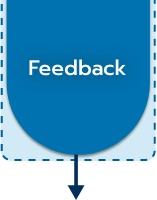Procedure: Check-Up Meeting – Feedback
Coaching Process > Check-Up Meeting – Feedback
Overview
Personalized feedback is a well-documented method for evoking motivation and positive changes in classroom environments. Teachers are in a better position to make good decisions about their classrooms when they receive very specific information about things that are going well in the classroom and things that could be improved.
There are four elements to delivering effective feedback:
How To
After you finish assessing the classroom, arrange a meeting with the teacher to review the personalized feedback, sharing both strengths and areas of concern across the domains of classroom structure, instructional management, behavior management, and classroom climate. In this same meeting, you will work with the teacher to identify strategies they will want to use in their classroom. You should anticipate the meeting taking about 45 minutes. In this section, we will review providing feedback.
The following breaks the feedback into introducing and providing an overview, delivering and processing the feedback, and transitioning to the menu of options and planning.
Introduction and Providing an Overview



Introduce the feedback form. Finally, prepare the teacher for the remainder of the session by giving an overview and then describing the feedback form. It can be helpful to use a blank feedback form when describing what the colors on the form mean.

- Show the teacher a blank feedback form first. Otherwise, their attention will be focused on how they were rated rather than listening to your overview.
- Try to sit side by side rather than across the table from the teacher. This setup conveys partnership and allows for shared viewing of the feedback form.
- As you review the feedback, keep a pad of paper next to you and write down areas the teacher wants to work on with you. Do not begin planning new strategies until you finish reviewing the form. Use the list as your menu of options for next steps.
Delivering and Processing Feedback

- “What do you make of that?”
- “Does that fit with how you see your classroom?”
- “What do you think of that?”
- “You seem surprised by that.”
- “You’re nodding your head and seem to agree.”
- “I noticed you cringed when I said that. What was going through your mind just then?”

Transitioning to Menu of Options and Planning an Intervention

Reflection & Tips:

References to Other Relevant Resources:
Herman, K. C., Reinke W. M., Frey, A., & Shepard, S. (2014). Motivational Interviewing in Schools: Strategies for Engaging Parents, Teachers, and Students. New York: Springer
Reinke, W., Herman, K., & Sprick, R. (2011). Motivational interviewing for effective classroom management: The classroom check-up. New York, NY: Guilford Press.









